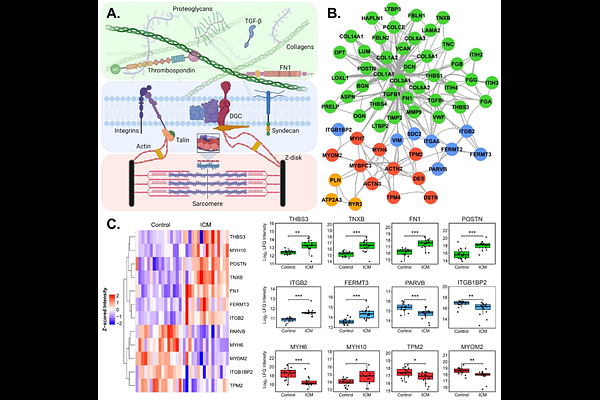Extracellular Matrix Alterations in Chronic Ischemic Cardiomyopathy Revealed by Quantitative Proteomics

Extracellular Matrix Alterations in Chronic Ischemic Cardiomyopathy Revealed by Quantitative Proteomics
Buck, K. M.; Rogers, H. T.; Gregorich, Z. R.; Mann, M. W.; Aballo, T. J.; Gao, Z.; Chapman, E. A.; Perciaccante, A. J.; Price, S. J.; Lei, I.; Tang, P. C.; Ge, Y.
AbstractIschemic cardiomyopathy (ICM) is a leading cause of heart failure characterized by extensive remodeling of the cardiac extracellular matrix (ECM). While initially adaptive, ECM deposition following ischemic injury eventually turns maladaptive, promoting adverse cardiac remodeling. The strong link between the extent of fibrosis and adverse clinical outcomes has led to growing interest in ECM targeted therapies to prevent or reverse maladaptive cardiac remodeling in ICM; yet, the precise composition of the ECM in ICM remains poorly defined. In this study, we employed a sequential protein extraction enabled by the photocleavable surfactant Azo to enrich ECM proteins from left ventricular tissues of patients with end-stage ICM (n=16) and nonfailing donor hearts (n=16). High-resolution mass spectrometry-based quantitative proteomics identified and quantified over 6,000 unique protein groups, including 315 ECM proteins. We discovered significant upregulation of key ECM components, particularly glycoproteins, proteoglycans, collagens, and ECM regulators. Notably, LOXL1, FBLN1, and VCAN were among the most differentially expressed. Functional enrichment analyses revealed enhanced TGF{beta} signaling, integrin-mediated adhesion, and complement activation in ICM tissues, suggesting a feedback loop driving continued ECM deposition in the end-stage failing heart. Together, our findings provide a comprehensive proteomic landscape of ECM alterations in the end-stage ICM myocardium and identify promising molecular targets for therapeutic intervention.